“All generations shall call me blessed,” she correctly predicted in her famous song of prayer, the Magnificat (Luke 1:48). From late antiquity to the present, images of Mary during her miraculous pregnancy, cradling the infant Jesus, suffering at his death, praying at his Ascension, and being crowned heavenly queen have populated Europe, the Middle East, Africa, and the Americas. Whether wandering the countryside of Poland or Costa Rica, you will find her there. Catholic doctrine acknowledges these diverse forms of popular piety toward the Virgin Mary, while also emphasizing that “true devotion consists neither in sterile or transitory affection, nor in a certain vain credulity” toward Marian traditions (Lumen gentium, Vatican II).
Humble images of Mary in roadside shrines are commonplace, but her story has always been “attractive to great artists” too, as Andrew Greeley explains in The Catholic Imagination: “The reason was that the stories and the lurking metaphors had enormous appeal to the human imagination. Once humankind recognized the Mary stories, they became irresistible.” Marian art has certainly been irresistible for “all generations” of the Catholic tradition. But in the course of writing my new book, How Catholics Encounter the Bible, I was forced to reckon with a vexing question for a biblical scholar: In what ways are these images of Mary biblical?
Our story of Marian art will begin and end in Rome, from one fifth-century basilica to another. Following the Council of Ephesus (431), which confirmed Mary’s doctrinal status as Theotokos (Greek for “God-bearer” or, colloquially, “Mother of God”), the Roman basilica of Santa Maria Maggiore was constructed. Pope Sixtus III (432–40) celebrated the council’s decision by overseeing a maggiore mosaic program of new artworks about the life of Mary, installed on the arch over the apse. Covering four horizontal registers on both sides of the arch, the gilded mosaics show scenes from the Annunciation (Luke) through the Flight to Egypt (Matthew), weaving in details from non-canonical stories, too.
The first two scenes show the Annunciation to Mary and a separate annunciation to Joseph above an extravagant scene of the Nativity. This Annunciation imagines Mary as a Roman woman of noble, even regal, lineage, arrayed in gold and enthroned while weaving from a basket at her side. Since the Annunciation scene in the Gospel of Luke does not indicate any precise location, the earliest Christian depictions place her either outdoors at a water well or in the act of spinning (weaving) near or within the Jerusalem Temple. These are both part of a double Annunciation narrative in the earliest non-canonical biography of Mary, a widely circulated text from the second century. (Later medieval and Renaissance depictions place her almost exclusively indoors in a home.) Mary is surrounded by a whole set of angels, not just the lone Gabriel, suggesting a powerful entourage of protection.
In the Nativity, she has demoted herself somewhat, giving up her seat and her heavenly entourage to the infant Jesus. The star above and the identifying halo on the infant guide the way for the magi. The imagery overall shows the story of a ruling lineage, but one in conflict with enemies at home (Herod) and abroad (in Egypt). Thus the artistic program, besides honoring the new status of Mary as Theotokos, also echoed the challenges faced by imperial Rome, which had recently been sacked by foreign armies for the first time in eight hundred years.
The mosaics of Santa Maria Maggiore were necessarily innovative and, in some ways, peculiar forays into Marian iconography. By the late medieval era, though, the visual vocabulary had stabilized. Several core images are captured efficiently by a fourteenth-century painted triptych from Venice. Central is the Madonna and Child, a tender image of Mary as an everyday mother, a picture more devotional than literal. The text of Luke does state that she “wrapped him in swaddling clothes” before laying him in a manger (Luke 2:7), but one hardly needs a text to prove that a mother held her child. The primary goal of this artwork is to foster devotion to the maternal bond of Mary with Jesus, and the framing biblical scenes are like citations—references to enhance reverence.
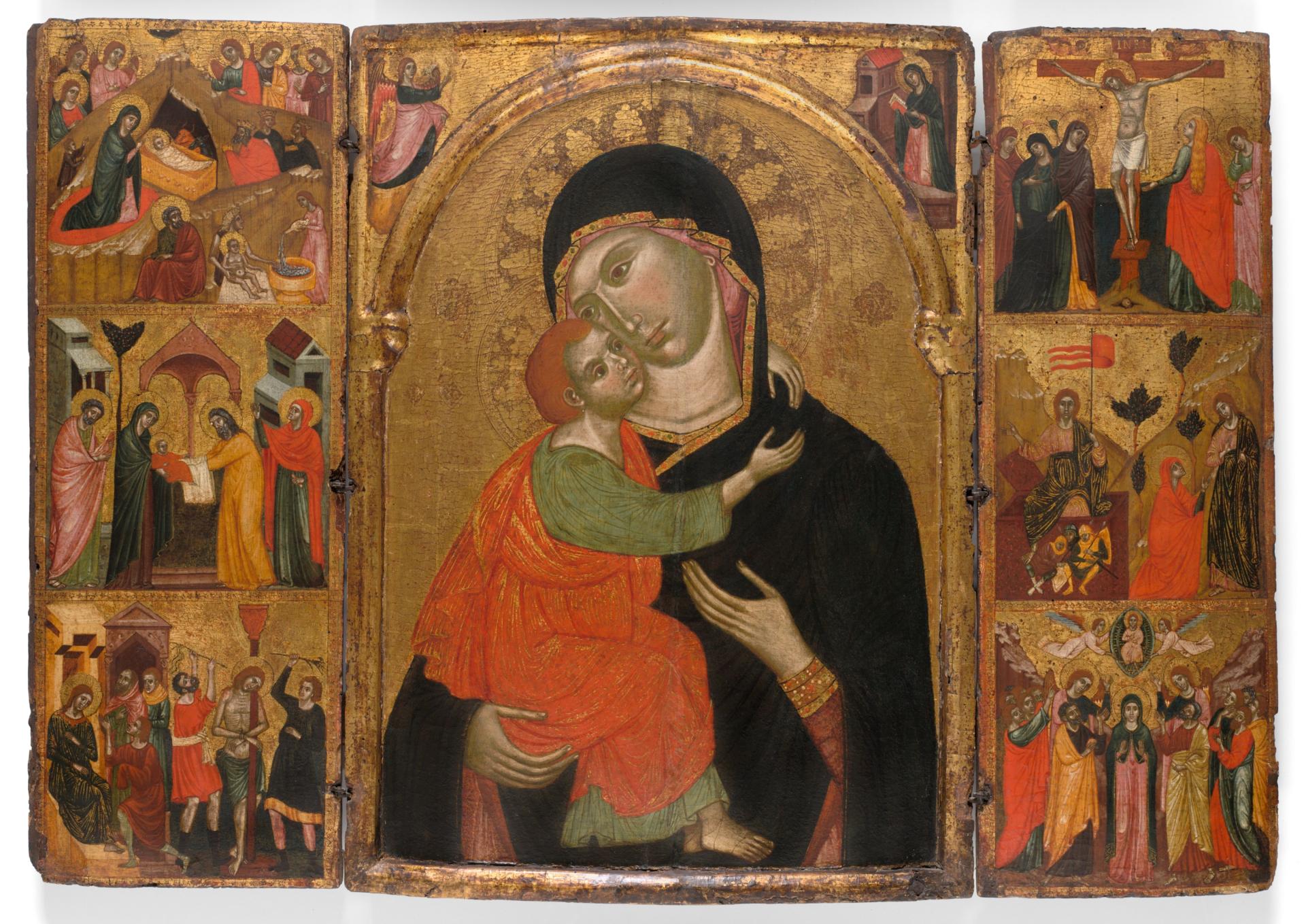
Of the surrounding scenes, the first in narrative order is the Annunciation, which jumps across the spandrels of the central panel, above the arch. This resembles in miniature how the Annunciation was often featured in church architecture and painting—Gabriel and Mary separated by a window, door, or otherwise open space to symbolize the incarnational leap from heaven to earth. Moving downward on the left side, we see the Nativity and the Presentation of Jesus as an infant in the Temple (Luke 2:22–38). After receiving a blessing there from the prophet Simeon, she was warned that her son would be opposed and “a sword [would] pierce” her heart, too (Luke 2:35). The artistic program uses that as a springboard to jump straight to Jesus’ suffering and death, leaving out the presence of Mary at the wedding at Cana (John 2:1–12). Here as elsewhere after late antiquity, the miraculous ministry of Jesus has been subordinated to his beginning and ending. Jesus is mocked and flogged, and Mary is prevented from being present to comfort him. She then reappears in the upper-right panel, fainting from grief at the cross, her soul pierced as was prophesied. To the right of the cross, standing in a posture not of grief but of faithful awe, is Mary Magdalene. Identified by her bright red garment and unveiled hair here at the cross and at the Resurrection appearance below that, Mary Magdalene was emerging as an influential female counterpart to the Virgin Mary during the medieval era—here seen as an upright disciple, influenced by Venetian Byzantinism, and not as a Western-style “maudlin” penitent. Finally, the Virgin Mary again takes center stage in the scene of the Ascension, positioned as the leader of a small band of disciples in Jerusalem after Jesus’ Resurrection (Acts 1:14). Among those present, only she has the halo of a saint, being closer to the angels, it seems, than to the twelve male disciples.
To see how Marian art is biblical art, we can categorize the most common images of her into three groups: first, those derived directly from the New Testament; second, those derived by typological interpretation of the Old Testament, when a “pattern” or “type” (the Greek word typos) from the Hebrew Bible was thought to be adapted or fulfilled by figures and events in the New Testament; and third, those that are visualizations between or beyond the lines of Scripture. Many of the most frequently depicted Marian scenes are, in fact, drawn from the New Testament. By far the most prominent is the Annunciation. In his magisterial Mary Through the Centuries, historian Jaroslav Pelikan surmises that if we had a complete citation index of all Christian art, the number of references to the Annunciation would exceed the references to all other Marian scenes combined. And the story is profoundly biblical, expressing not only this unique moment of Incarnation but also resonating with the miraculous pregnancies and mysterious ways of God’s activity in the Old Testament. The fifteenth-century Annunciation panel by Jan van Eyck magnificently shows how biblical interpretation can be painted through this story.
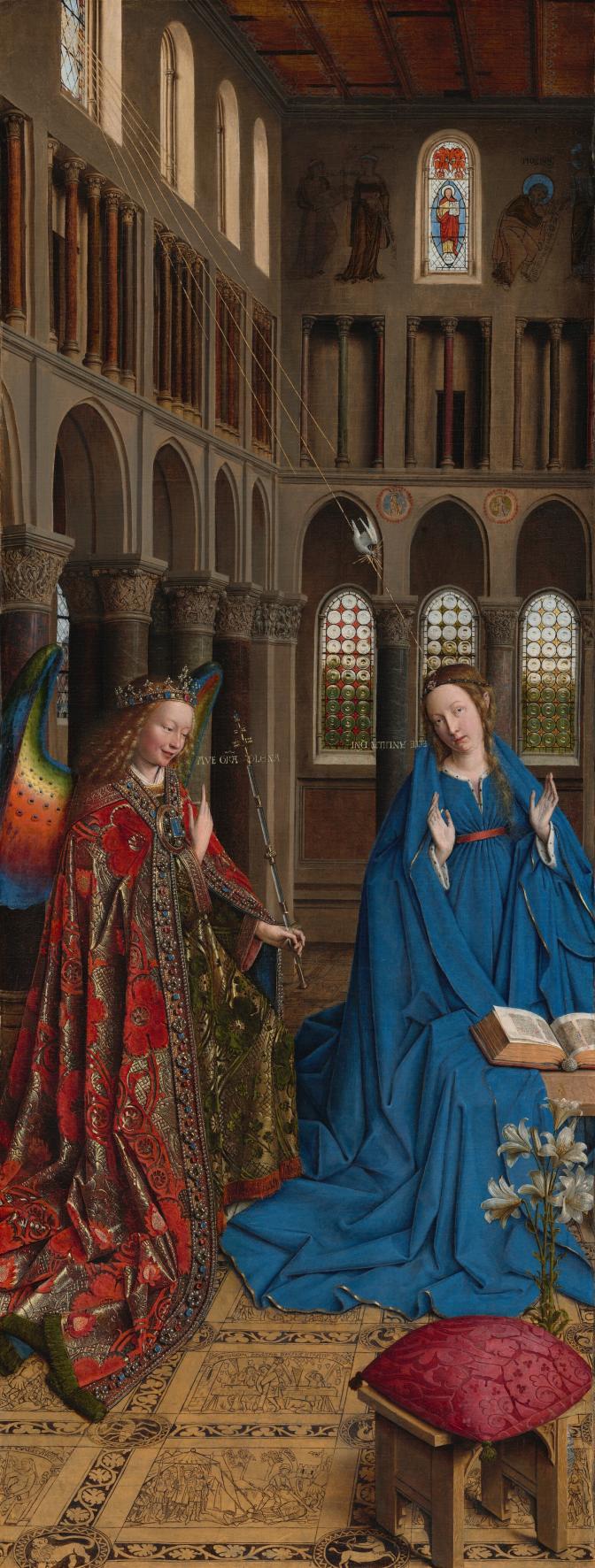
Iconography tends to accumulate features over time. One sees here Mary’s traditional blue garment, the lilies symbolizing her purity, her book open to the prophets, even as her heart was open to her unexpected visitor, the written dialogue of “Ave, gratia plena” (“Hail, full of grace”) and “Ecce, ancilla Domini” (“Behold, [I am] the handmaid of the Lord”), and the Holy Spirit as a dove riding the lines of Incarnation from heaven. To these traditions, van Eyck has added even more biblical depth. For Luke, the Incarnation is a “Holy Spirit” which would descend upon Mary; for John, the “life” that came into the world at this moment was “the true light” of the whole human race (John 1:1–9). That life enters as light through clear glass, a substance that allows light to penetrate inside without losing its intact purity. The transparent glass of the Incarnation, while clearly symbolizing the perpetual virginity of Mary, is also a biblical interpretation of John. As for the dove, it glides down along not one but seven streams of light. This, too, is a biblical expression of the seven gifts of the Holy Spirit, which interpreters reasoned Mary received at this moment of grace. These gifts, enumerated in the same messianic prophecy that anchored the Messiah’s Davidic lineage, were a model of saintly rule (Isaiah 11:1–3).
To round out the biblical allusions, we move past the light-soaked windows to inspect the shadowy walls and even the floors of the room in the panel. They are painted with relevant scenes from the Old Testament: the upper wall shows the miraculous salvation of Moses as a baby and his later reception of the law from God. The floor underneath Mary’s feet shows snapshots of valor from the Old Testament: two from the life of Samson, and one of David defeating Goliath. Mary’s song, the Magnificat (Luke 1:46–55), had praised how God showed “might with his arm” (like Samson) and “threw down the rulers from their thrones but lifted up the lowly” (like David over Goliath). The Old Testament stories suggest that this building is van Eyck’s imagining of the Jerusalem Temple, where many non-canonical stories situate Mary during the Annunciation. Surrounding the action contained therein, the building itself establishes typological possibilities for biblical interpretation, like a visual sermon on this most popular of Mary’s stories.
Other frequently depicted Marian stories from the gospels and Acts include the Visitation to Elizabeth, Nativity, Adoration of the Magi, Crucifixion, Resurrection, and Ascension. The miracle of water turned into wine at Cana, however, recedes into the background (John 2:1–12). As for the episode in which Mary questions her son and he rebukes her (Mark 3:31–35), that might as well never have happened as far as the artistic record is concerned.
In addition, the presence of Mary at the Ascension is not directly stated in the text but only inferred from it. In Luke, Jesus’ final moments on earth are with “the eleven and those with them” (24:33), and in Acts, Mary is listed among the first community in Jerusalem (1:14). For this reason, Christian artists generally position her at the Ascension.
Identifications of the women in the empty-tomb and Resurrection sequences are more complex. Mary Magdalene is the consistent textual presence in the gospels, while the Virgin Mary joins her as a consistent artistic presence (at least in the Western tradition). Perhaps this is not so much a departure from the biblical text as an attempt to make sense of it. If Jesus’ mother is there at the cross (in John) and also in Jerusalem with the disciples after the Resurrection (in Acts), then wouldn’t it make sense for her to have been present in between? And surely his grieving mother would have visited his tomb? This is also how St. Ignatius Loyola imagined the scene in his influential Spiritual Exercises. Just as in Michelangelo’s Pietà, in which Mary holds the lifeless body of her son after it was taken down from the cross, her attending to his burial was a natural extrapolation from the biblical story.
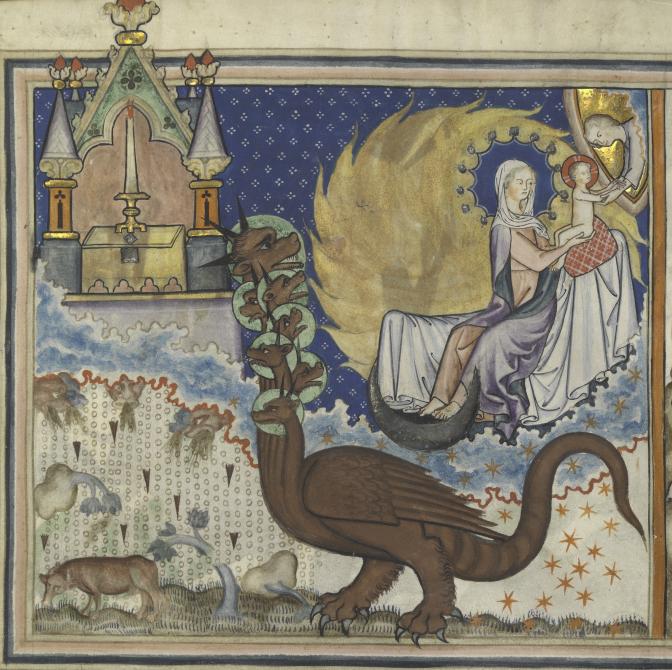
Beyond explicit references in the gospels and Acts, Mary has also been found in the final book of the New Testament, the Apocalypse or “Revelation.” The central section of this obscure, image-filled vision narrates a cosmic battle between good and evil, with dragons, beasts, warrior angels, and more. To kick it off, “a great sign appeared in the sky, a woman clothed with the sun, with the moon under her feet, and on her head a crown of twelve stars. She was with child and wailed aloud in pain as she labored to give birth” (Revelation 12:1–2). She gave birth to a son who was “destined to rule all the nations with an iron rod” and was “caught up to God and his throne” (Revelation 12:5). With this messianic vision of Jesus, it was inevitable that the woman clothed with the sun would be interpreted as Mary. Among the first to connect this text with an image was a fourteenth-century illuminated manuscript called the Cloisters Apocalypse. Here we see the Marian iconography of her blue garment, a halo crown of twelve stars, surrounded by a sunburst, with the moon as her footstool. She hands her child, identified as Jesus by his cruciform halo, through a portal to God the Father. The upper left depicts the heavenly temple and the ark of the covenant described in the previous verse (Revelation 11:19), and the juxtaposition suggests a typological interpretation. Just as God’s presence had temporarily dwelt in the ark and temple in the past, so, too, was God’s presence on earth incarnated in the womb of Mary.
If some features of the Cloisters Apocalypse look vaguely familiar to readers in the Americas, that’s because they resemble what is perhaps the most influential image of Mary on these continents: Nuestra Señora de Guadalupe, who appeared in 1531 on the outskirts of what is now Mexico City. And if the iconographic similarities between the fourteenth- and sixteenth-century examples are not immediately recognized, a fifteenth-century stained-glass image of Mary as the woman clothed with the sun helpfully fills in the gap. In Latin America, the southwestern United States, and the Philippines, the image of Our Lady of Guadalupe from St. Juan Diego’s tilma is ubiquitous—in churches, of course, but also in restaurants, sidewalk murals, homes, jewelry, and tattoos. Journalists have documented hundreds of public murals and shrines to Our Lady of Guadalupe in just one section of Los Angeles. I once saw a makeshift shrine to her behind a gas station in rural California, where workers were taking a smoke break in her presence. She was nestled there among trash cans and empty delivery pallets. Like the Incarnation itself, Our Lady of Guadalupe appears where you least expect to find her.
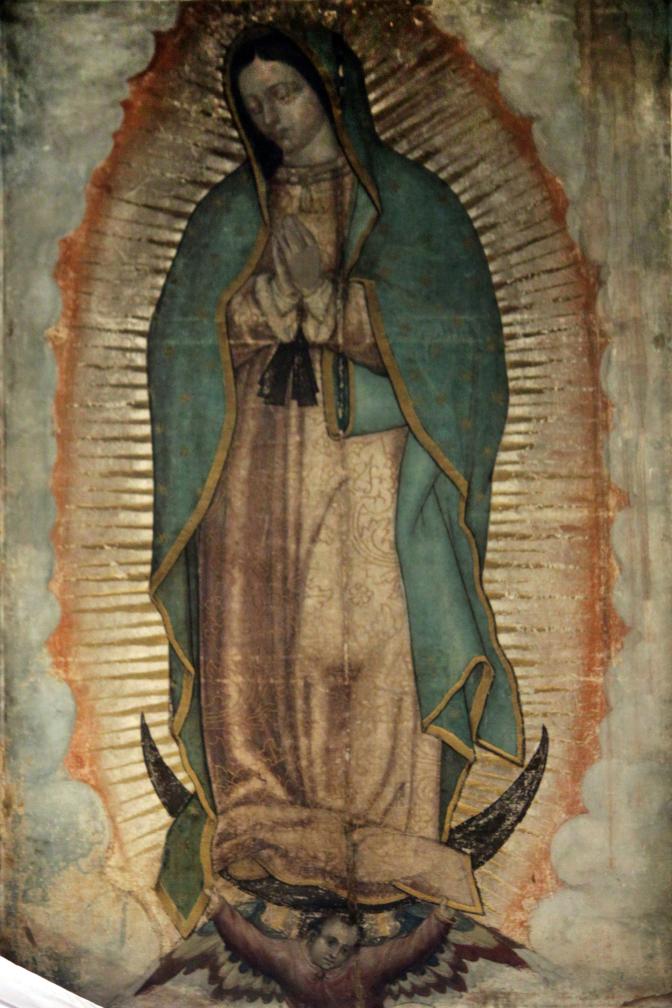
In Guadalupan spirituality, as in the iconography of the tilma, this Mary is absolutely a biblical Mary. In the words of Fr. Gilberto Cavazos-González, a professor of spirituality and scholar of Guadalupan devotion: “The image of Mary in the Gospel of Luke is not a humble servant woman. She’s a woman who’s determined. She’s a woman who’s powerful and, in the only prayer that we have of the Virgin Mary to God, she pretty much challenges God to side with the poor.” Guadalupe’s other biblical connection, to the woman of Revelation, was championed by her most important early interpreter, Miguel Sánchez (1594–1674). A substantial portion of his crucial work, Imagen de la Virgen María, Madre de Dios de Guadalupe (1648), is a word-for-word application of Revelation 12 to Our Lady of Guadalupe. D. A. Brading’s monumental scholarly study of Guadalupan history, Mexican Phoenix, shows how Sánchez also went far beyond the “woman of the Apocalypse” to model the Guadalupe events on the prior biblical account of the Exodus, especially Moses’ encounters with God at Horeb (the burning bush) and Sinai (the giving of the law).
His deployment of typology was thus not a question of metaphor…but took the form of a re-enactment in which Juan Diego acted like Moses, with the image of Guadalupe not merely identified as the staff used both by Moses and Aaron to impress Pharaoh, but also as the Ark of the Covenant with the Tables of the Law.
Like the artist of the Cloisters Apocalypse, Sánchez derives theological insight from the juxtaposition of the ark of the covenant and Mary. Both bore the divine presence on earth to a messenger who needed God’s wondrous sign to persuade an earthly ruler.
Other appearances of Mary in Catholic art have been drawn from typological interpretations of the Old Testament cultivated through centuries of sermons, biblical commentaries, liturgies, and artworks. First, Mary has been positioned in salvation history as the New Eve. Such an idea flowed from the biblical identification of Jesus as the “Second Adam” or “New Adam” in the theology of Paul (1 Corinthians 15:45–49; Romans 5:12–21). But since the story of the Garden of Eden dramatizes Eve’s role, too, early Christian theologians found in Mary a resetting of humanity’s relationship to God. If the biblical Eve was known primarily for disobedience, Mary became known for her obedience to God’s will at the Annunciation (“Let it be done to me according to your word”). Fra Angelico’s fifteenth-century Annunciation, for example, positions Mary and Gabriel in a colonnade directly adjacent to the Garden of Eden. Beams of light, which carry the Holy Spirit toward her, originate from the sunshine over Eden; the “let there be light” (fiat lux) of God’s creation is recapitulated in the new creation of the Incarnation (“let it be done to me,” fiat mihi). Medieval composers of poetry and music expressed this juxtaposition through a Latin palindrome: the sin of Eve (Latin Eva) was reversed by the Annunciation’s “Hail” (Latin Ave). The widespread medieval chant Ave Maris Stella makes the claim explicit: “Hail, star of the sea, dear Mother of God and ever-Virgin, happy gate of heaven. Receiving that Ave from the mouth of Gabriel, establish us in peace, changing the name of Eva.”
If Adam and Eve were a couple, then the “New Eve” idea implies that Jesus and Mary were also a couple. This seems decidedly non-biblical at first glance. But Mary as the “bride” of Christ—and thus a symbol of the Church as bride of Christ—was an artistic expression also rooted in typological interpretation of the Old Testament. The biblical key here is the Song of Songs, the Hebrew love poem that fits awkwardly into the Old Testament canon. From at least the third century, Christians have interpreted this text primarily as an allegory of God’s salvific love for humanity (following the tradition of Jewish allegorical interpretation of the work).
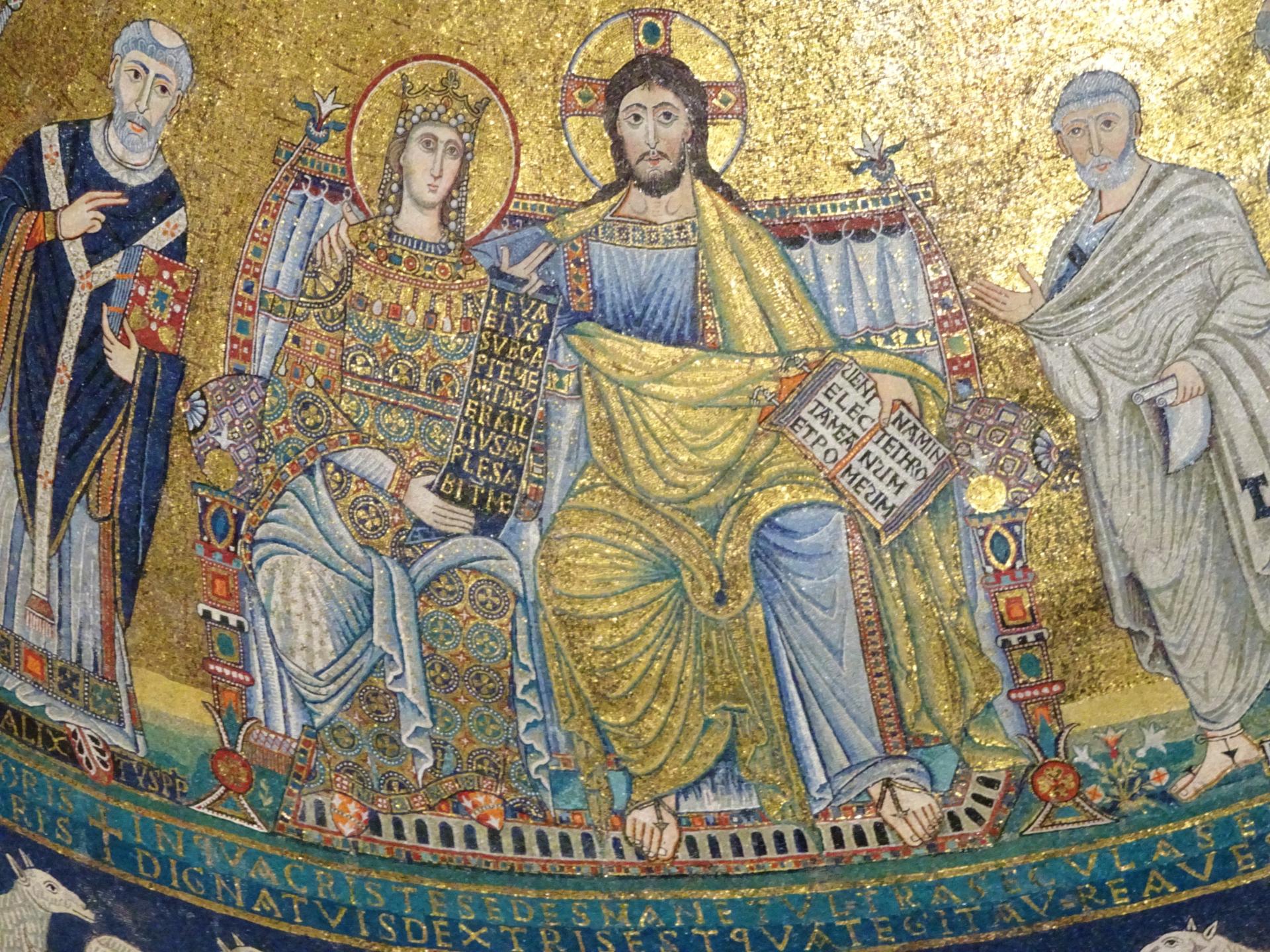
If one walked into the Roman church of Santa Maria in Trastevere without knowing much about Catholic history or iconography, one might think the resplendent twelfth-century apse mosaic depicts a regal couple, perhaps an Italian king and queen from centuries ago. To be sure, the imagery is regal, with gold and blue garments, thrones, and a crown atop the female figure. The man’s right arm is wrapped around her back and shoulder. The cruciform halo gives away his identity, though, and one realizes that this is Jesus with Mary. As if to dispel any possible confusion, each figure holds a Latin textual message. Mary’s says, “His left [arm] is under my head, and his right embraces me.” This quotation from the Song of Songs (2:6) only partially describes their pose in the mosaic, but it does signal the biblical typology at work: Mary represents the Church’s role as the beloved of Christ. For his part, Christ’s message comes not from Scripture but from the Golden Legend, where he welcomes his mother into heaven as his “chosen one upon my throne.” The medieval viewer was presumed to be familiar with non-biblical traditions about Mary’s afterlife.
Another of the bride’s quotations in the Song of Songs has influenced Marian imagery in a quite different way. One of the first things the beloved says in the poem is “Black am I, and beautiful” (1:5). Due to the typological connections between this bride and Mary, the textual bride’s blackness seems to have influenced the artistic tradition of “Black Madonnas” (or “Black Virgins”) throughout the Catholic world. These are sculptures or painted icons—some dating to the medieval period—that depict Mary (or Mary and Jesus together) carved out of dark material or painted with dark skin tones. One catalog of Black Madonnas attests almost two hundred examples, mostly in Europe, with some in Africa, Southeast Asia, and the Americas. Among the most famous in Europe are Our Lady of Einsiedeln (fifteenth century, Austria) and Our Lady of Częstochowa (ninth to fourteenth century, Poland), the latter of which is among the most popular pilgrimage destinations in Europe. Most Black Madonnas have mysterious origins, deep roots in national identity, and wondrous effects on individual pilgrims.
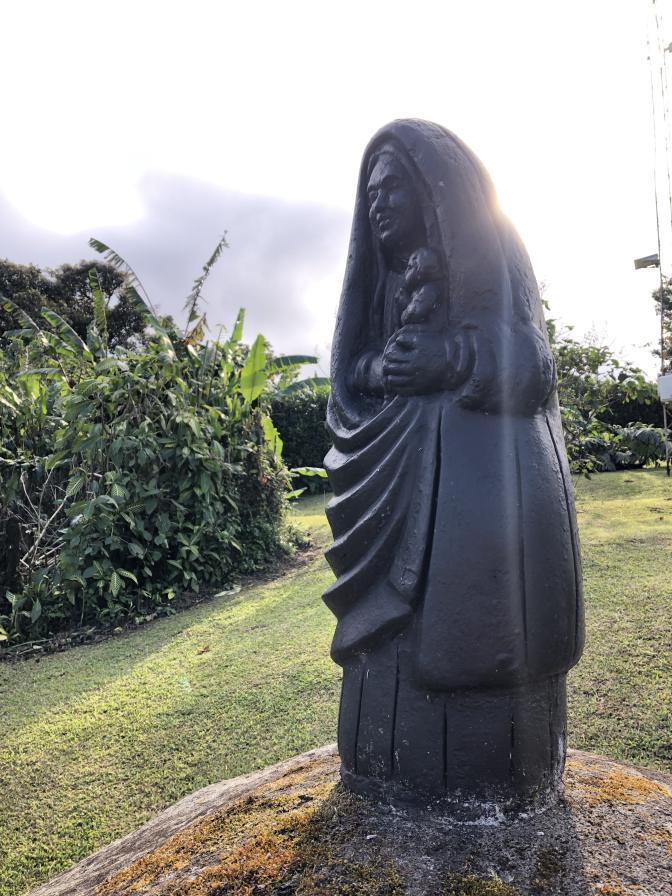
Just southeast of San José, Costa Rica, in the town of Cartago, stands a grand Catholic church built to house a very small item: an eight-inch-tall carved black stone, an image of Madonna and Child. It is known as the Virgin of the Angels (Virgen de Los Ángeles), because it was found in 1635 on August 2, the day Franciscans commemorate Our Lady of the Angels. In Costa Rica, she is simply called La Negrita, and copies of her image are found throughout the country (one such replica is shown here). Each year leading up to her feast day, which is a national holiday, approximately two million pilgrims—almost half the population of the country—visit her in Cartago, most of them having walked from San José. The location is crucial, as the founding story of La Negrita proves that she is not easily movable. According to tradition, both Juana Pereira, who found the stone in 1635, and the pastor who assessed her situation had moved the stone from its original spot—only to discover that it kept miraculously returning to that place. So on that spot they built her first church.
But why do Costa Ricans continue their devotion four centuries later? Scholar of religion Elina Vuola, who has done extensive fieldwork interviews with Costa Rican women about La Negrita, found that Mary’s virginity is not an emphasized feature of her story. Rather, they talk at length about the experience of motherhood, struggle, and the empowerment they feel from La Negrita. This is the biblical Mary of the unplanned pregnancy, the one who prays to “lift up the lowly” and “fill the hungry with good things” (Luke 1:52–53). Unlike many Marian apparitions around the world, La Negrita did not speak to the person who first met her, yet the historical context and later reception show there was a clear meaning for her visit. “The common interpretation of the story is that La Negrita, who herself was dark-skinned and appeared to a person of despised race, had a clear message: that both ‘whites’ (blancos) and ‘blacks’ (negros) are God’s children and thus equal.” A colonial encounter combined with a “black and beautiful” Madonna both to empower women and foster national unity.

A final example of typological interpretation of the Old Testament concerns Mary’s coronation as a “queen.” Medieval Christians reasoned that if Mary was a heavenly “bride” of Christ, and Christ is heavenly “king,” then Mary must also be “queen.” She wears a crown in the apse mosaic of Santa Maria in Trastevere, and three of the top four Marian antiphons (chants) from medieval Catholic liturgy have “queen” in their title (Salve Regina, Regina Caeli, and Ave Regina Caelorum). Undoubtedly some of this fervor for her coronation stemmed from zeal for monarchy in Europe; however, it continues in the annual custom of “May crowning” of statues of the Virgin Mary. Protestant observers look askance at such rituals, but Catholic theologians have long established their biblical warrants, especially through the “royal Psalms” of the Old Testament. Psalm 45 is one of the most interpreted Psalms among Christian theologians, as it seems to be filled with predictions of a coming messianic king. That Davidic king had “a queen at his right hand, arrayed in gold.” Just as medieval interpreters found three “kings” in the Psalms to interpret the Magi, here they also found their “queen.”
A queen deserved opulent regalia, such as Paolo Veneziano used in his fourteenth-century Coronation of the Virgin. Not only is the gold leaf abundant (as the Psalm states), but the royal blue of her exquisitely textured garments is lapis lazuli, an extravagant pigment made from a deep blue rock imported from the Middle East. And like any regal ceremony or festive Psalm, this one is surrounded with music. The heavenly choir sings and plays the full slate of medieval instruments: trumpets, lutes, harps, tambourines, and even portable pipe organs. The angels in the back row are the singers and—to help the viewer sing along—Veneziano has subtly provided lyrics along the platform’s base. Of course, most viewers knew the opening words of Regina Caeli by heart. A medieval melody, reimagined through a royal Psalm, arrayed in gold.
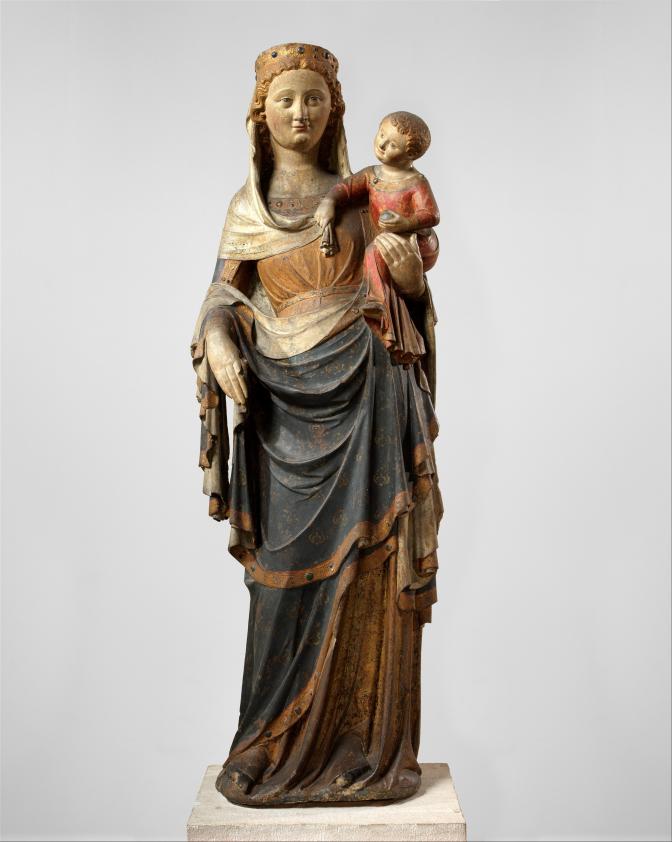
A third category of Marian art takes its inspiration from between and beyond the lines of scripture. Such art may depict Mary with everyday maternal postures and gestures, like the countless versions of Madonna and Child or the Nursing Madonna (Virgo lactans)—a style perhaps influenced by iconography of ancient maternal deities, such as the Egyptian Isis. Other types show Mary in the pose of a busy mother, holding her baby on her hip while moving about. The boy clutches at her garments, like any ordinary child would do, even as her crown reminds the viewer of his unique destiny. Like the Costa Rican women devoted to La Negrita, women in medieval Europe were drawn to the quotidian responsibilities of Mary as a mother.
In the past two centuries, the Catholic Church has promulgated two dogmas about Mary that bookend her life. The dogma of her Immaculate Conception—which teaches that Mary was conceived without sin—was officially defined in 1854, but its theological roots go back to early Christianity. The standard artistic representations of the Immaculate Conception are not very distinctive: a regal Mary with a crown of twelve stars (as in Revelation 12). However, the artistic representations of the end of Mary’s earthly life—her “Dormition” and “Assumption”—are diverse and fascinating. The Dormition (“falling asleep”) often features the Virgin surrounded by the Apostles (minus Judas Iscariot and Thomas), a story passed on in the Golden Legend and featured as the center of a fifteenth-century wooden altarpiece on permanent display at the Cloisters museum. A visitor can immerse herself in this diorama, peering inside the censer alongside the apostle at the foot of the bed. The official Catholic dogma that Mary was “assumed” body and soul into heaven was not promulgated until 1950, and it can be understood as a modern attempt to define Catholic piety more sharply vis-à-vis Protestantism. Most of the artworks associated with the Assumption are recent and often gaudy. Yet new research shows that the Assumption has deep roots in the Catholic tradition.
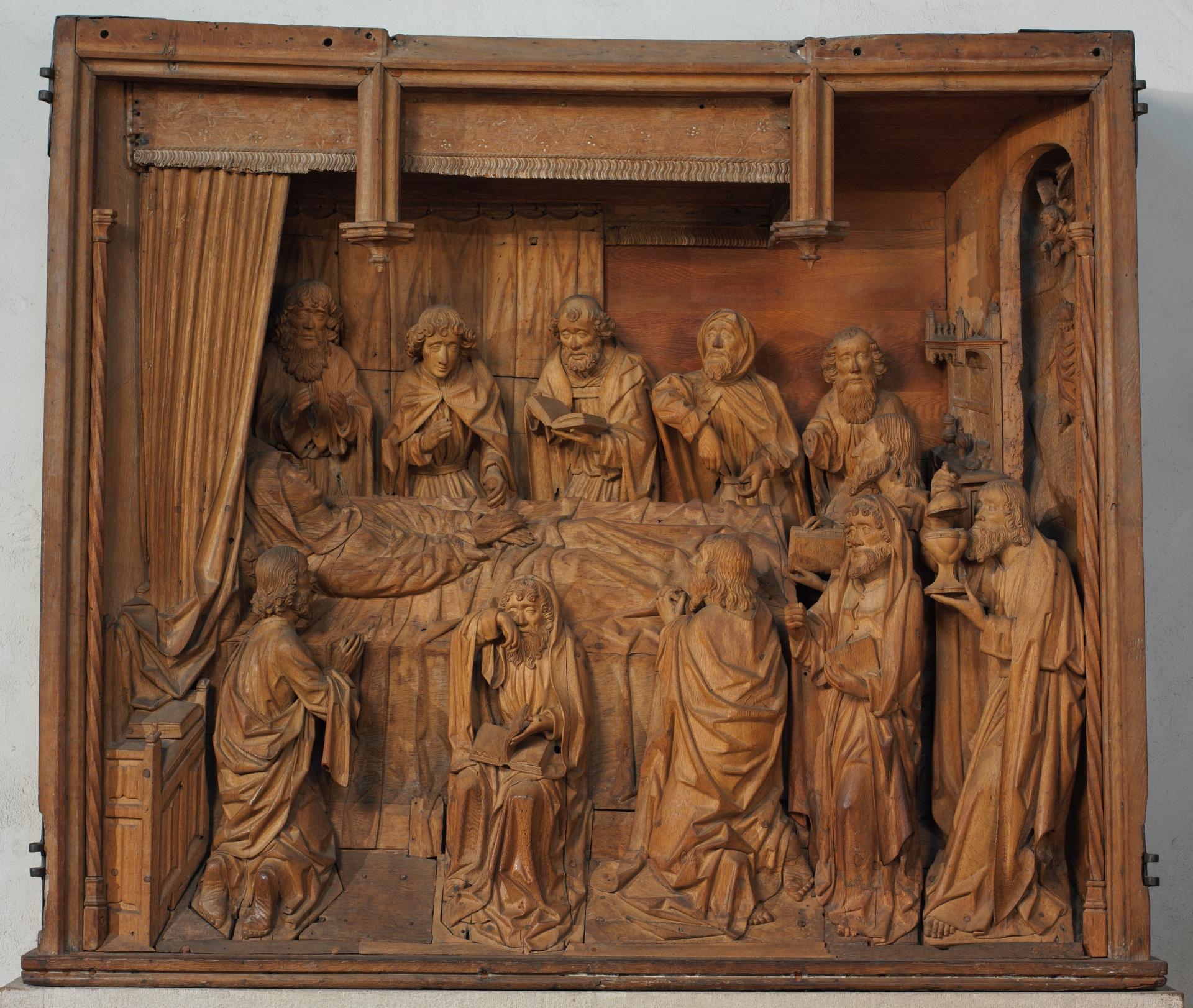
First, there were already well-known biblical precedents for bodily assumption into heaven: Enoch, who “walked with God” and “God took him” (Genesis 5:24); and Elijah, who was taken up in a flaming horse-drawn chariot and whirlwind (2 Kings 2:11). Second, as the esteemed historian of religion Stephen Shoemaker has shown in Mary in Early Christian Faith and Devotion, traditions about her Dormition and Assumption were actually well developed in late antiquity. The evidence doesn’t allow us to see much before the fifth century, but that is true for many topics of early Christian history. By the fifth century, there is a solid textual tradition of liturgy; by the sixth century, a calendrical feast day; and it only grows from there. In an article published in the Journal of Early Christian Studies, Ally Kateusz has argued that a fifth-century artistic image of Mary’s Assumption has been hiding in plain view in Rome. The well-known wooden doors of the basilica of Santa Sabina preserve some of the earliest extant biblical art, including one of the earliest depictions of the Crucifixion. Eighteen panels show biblical scenes, most of which have solid identifications. But one panel has puzzled commentators; even Princeton University’s magisterial database, the Index of Christian Art, isn’t sure how to label it.
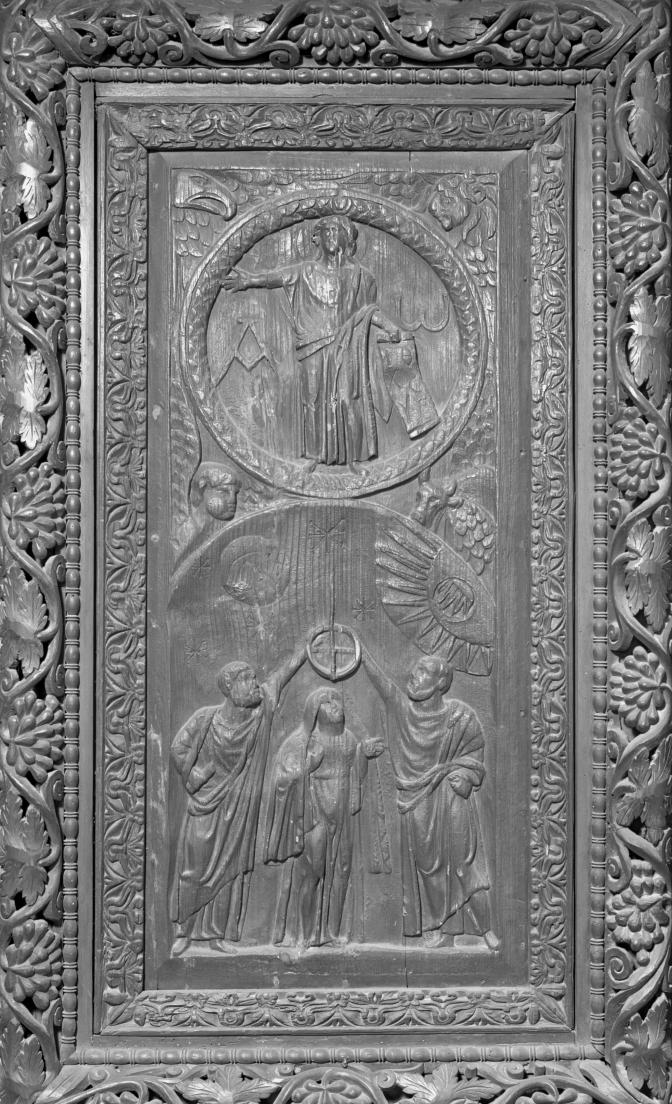
The upper register shows Christ encircled by a wreath bearing the alpha and omega and holding an unfurled scroll with the ΙΧΘΥΣ acrostic. The symbols of the four gospels are in the corners, as in other contemporaneous imagery of the heavenly realm. The lower register centers on a veiled female figure, arms extended in prayer and gaze raised heavenward. She is flanked by two male figures who hold a circle inscribed with a cross over her head, while the sun, moon, and stars shine above, separating earth from heaven. This has often been identified as the Ascension of Christ, but there are two problems with that interpretation: first, the artistic focus of the carving is the action over the head of the female figure; second, there is already a depiction of Jesus’ Ascension elsewhere on the Santa Sabina doors. Instead, Kateusz argues—building upon Shoemaker’s research—that this is an early visualization of the Assumption of Mary, while Peter and Paul honor her crowning achievement. Christ is not ascending, as was presumed; he is descending to retrieve her.
If Kateusz is correct, then there was already in fifth-century Rome—across town from the mosaics of Santa Maria Maggiore with which this essay began—a depiction of Mary’s Coronation and Assumption. These are still celebrated today in Catholic liturgy, using the same biblical sources. On the feast day of the Assumption (August 15), the first reading at Mass is drawn not, as usual, from the Old Testament but from the book of Revelation. The congregation hears first from Revelation 12, followed directly by a call-and-response excerpt from Psalm 45: that “woman clothed with the sun and crowned with twelve stars” is also a “queen arrayed in gold.”

